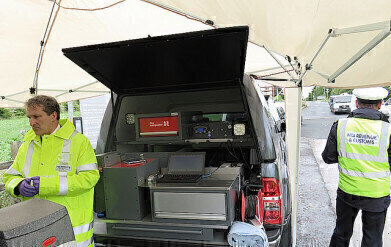GC-MS
How is Fuel Fraud Detected?
Feb 10 2016
Costing significantly less than regular diesel — red diesel has for years been used illegally as a source of fuel for cars and lorries on UK roads. But a recent development in Northern Ireland is being heralded by the UK government in the fight against fuel fraud — and chromatography is taking the lead in the fight.
Red diesel
Red diesel is the name given to the dyed diesel that can be used in registered agricultural vehicles and construction vehicles used off-road. The fuel is taxed at a significantly discounted rate when compared with standard diesel available at the petrol station forecourt — when you are paying 102 pence/litre for diesel, red diesel is available for 38 pence/litre.
Red, but not red
To differentiate between the two fuels, red diesel has a dye added turning the fuel red. This allows the authorities — in the UK it is Her Majesty’s Revenue and Customs (HMRC) — to detect if the fuel is being used illegally in vehicles on the road. With such a significant saving to be made by using red diesel — the risk of being caught hasn’t been enough to deter many users from breaking the law — the UK government estimates that the cost to the taxpayer is over £80 million per year in lost tax revenues.
With such a lucrative trade, many different methods have been developed to evade detection. One of the most common is to remove the red coloration from the diesel. In the UK, a diazo dye — Solvent Red 19, 24 or 26 — is used to colour the diesel. Fraudsters can remove the colour using an acid or alkali which renders the dye colourless, or by stripping the dye from the diesel using activated carbon.
Roadside GC-MS to the rescue
But the UK government is fighting back and has recently authorised a new roadside test aimed at combatting fuel fraud — and chromatography is the key.
Developed by the chemical company Dow, a chemical — ((3-(sec-butyl)-4-(decyloxy)phenyl)methanetriyl) tribenzene — is added to the diesel as a marker. Once it has been added to the fuel, it is difficult to remove — giving HMRC a better chance of identifying any fraud. The marker is easily detected using gas chromatography-mass spectrometry — but laboratory testing means delays in combatting the fraud.
But in Northern Ireland, the government has fitted fuel fraud detection units — using portable GC-MS — into 49 vehicles that can be used by HMRC enforcement officers to detect illicit fuel quickly and easily at the roadside. In a press release, a minister stated:
“The new marker and testing equipment are part of the significant investment we have made in HMRC to tackle avoidance, evasion and fraud to make sure all businesses and individuals contribute to the tax revenue that is used to fund vital public services.”
The use of gas chromatography in the fuel sector is discussed in the article, Determination of Biomarkers in Petroleum by Multidimensional Gas Chromatography: Fundamentals, Applications, and Future Perspective on Chromatography Today.
Image from HM Revenue & Customs
Digital Edition
Chromatography Today - Buyers' Guide 2022
October 2023
In This Edition Modern & Practical Applications - Accelerating ADC Development with Mass Spectrometry - Implementing High-Resolution Ion Mobility into Peptide Mapping Workflows Chromatogr...
View all digital editions
Events
ACS National Meeting - Fall 2024
Aug 18 2024 Denver, CO, USA
Sep 04 2024 Chiba, Tokyo, Japan
Sep 04 2024 University of Warwick, Coventry, UK
Sep 10 2024 Rockville, MD, USA
Plastics Recycling World Expo Europe
Sep 11 2024 Brussels, Belgium














